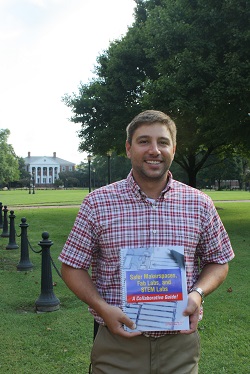
Tuesday, September 26, 2017
If you’re keeping up with the latest on educational settings for hands-on Science, Technology, Engineering and Mathematics (STEM) in the community and schools, you’ve probably seen the term, “makerspace.”
“Makerspaces have been popping up more recently in school libraries and media centers, which can pose safety issues if not designed and maintained correctly,” said Dr. Tyler Love, an associate professor and coordinator of UMES’ Technology and Engineering Education program.
Safer STEM-teaching students to use high-tech tools and equipment safely-was the inspiration for Love’s book, “Safer Makerspaces, Fab Labs and STEM Labs: A Collaborative Guide,” published August 31 by the National Safety Consultants LLC with co-author Dr. Kenneth Russell Roy.
“When you talk about safety and meeting the needs of instructors and students, it was the perfect collaboration for us, as the two head safety consultants representing STEM professional associations, to write the book,” Love said. Love is the International Technology and Engineering Educators Association safety editor and a National Science Teachers Association safety advisory board member. Roy is the NSTA’s chief safety consultant.
The two have published together before. This one, Love said was “a labor of love,” no pun intended, taking a little over a year to complete. The benefit of the book, he said, is that it highlights the importance of qualified STEM teachers like those prepared through UMES’ unique teacher education programs.
Love describes the book as “the only one on the market dealing solely with safety hazards, liability and safer designs regarding makerspaces, STEM labs and fab labs for primary, secondary and post-secondary schools, teachers, administrators and community centers and libraries.”
Edward C. McNett, assistant supervisor of career and technology education for Carroll County public schools concurred. “Finally a book that covers all of the aspects of safety for career and technology education from the legal aspects, facilities and equipment,” McNett said. “I believe “Safer Makerspaces, Fab Labs, and STEM Labs: A Collaborative Guide” is the most thorough and up-to-date safety guide for school-based fabrication areas and makerspaces.”
Howard County public schools provide each STEM department with a copy, Love said, and Purdue University is using the book in its STEM teacher-method courses with Love having introduced it in an online guest lecture. Kevin Justice of M4Reactor makerspace in Salisbury said, “Nothing like this currently exists.”
The book, which is being promoted by both national science, technology and engineering educator associations, features “information about liability and legal standards, better professional practices, safety controls, addressing biological/chemical/physical hazards, first aid procedures, the facility planning process, recommended designs and existing examples, and frequently asked safety questions.” It can be found online by visiting www.ITEEA.org.

